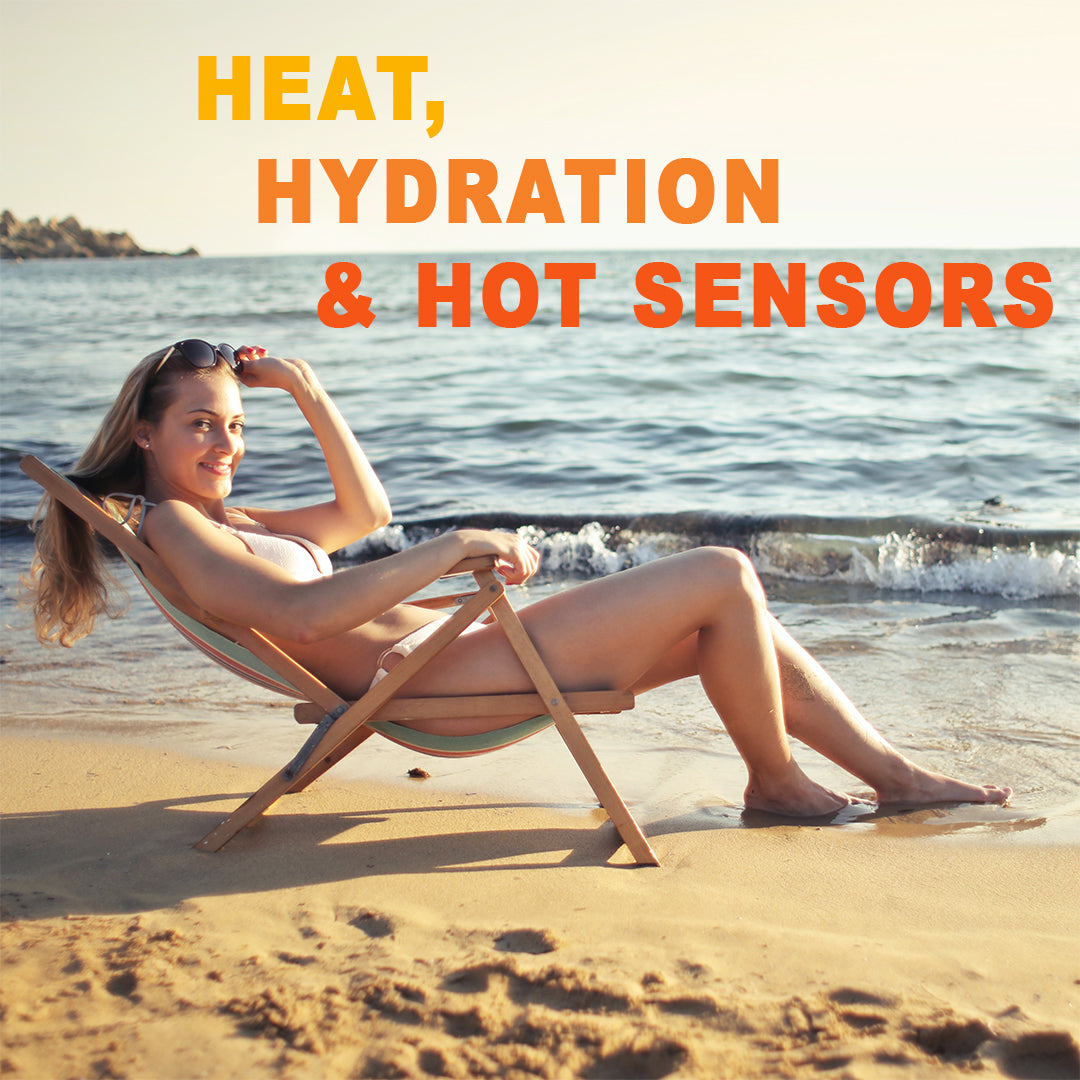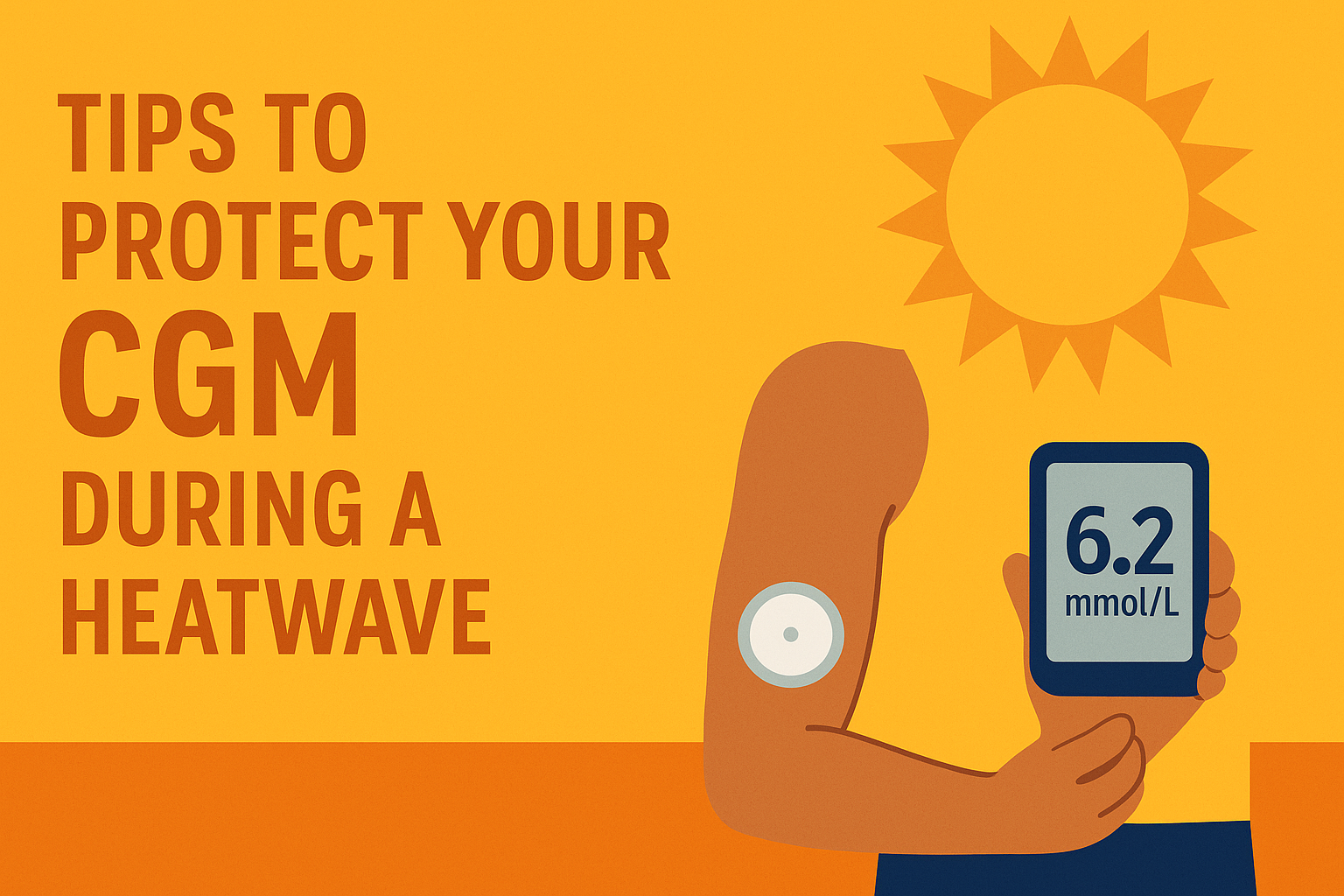
| Blogs and publications on this website are independent of any involvement by medtech companies or diabetes related charities. To ensure there is no bias, we do not accept any products, freebies or other material from any medtech provider. All materials are copyright©️Love My Libre Ltd. |
It's warming up! and for those with type diabetes it can be difficult to manage the heat. If you’re wearing a sensor it can affect your readings and also whether or not it stays stuck on!
This blog focusses on keeping hydrated and steps to avoid your sensor becoming unstuck.
💛💛💛
Hydration
The importance of drinking water, or other fluids, and keeping hydrated when it’s hot cannot be stressed enough.
As we all probably know, water is essential to life and this is also true for the life of a sensor. We regularly hear from potential customers looking for a solution to sensors sliding off due to sweat!
Related blog: Top 10 tips for getting your Libre sensor to stick. Click here.
💛💛💛
Why do we need to sweat?
Sweating is a necessary bodily function to regulate body temperature. It does this by cooling the skin through evaporation of excess heat. This is more difficult in high humidity i.e. a level of 75% or higher.
If there is too much water vapour in the air, or high humidity, it can be difficult for the body to cool down sufficiently. This is one of the reasons why sensors tend to come of more easily in hotter, more humid climates!
One of the consequences of sweating is that it increases blood flow to the skin which can lead to falling glucose levels, putting those with diabetes at risk of experiencing a hypo and dehydration which can lead to heat stroke.
Scientific evidence has shown that persons with diabetes sweat more than the average person. Additionally, those with type one diabetes aremore likely to sweat in the upper body than the lower body.
💛💛💛
Why is drinking water important?
Our bodies and organs are composed of a significant amount of water and the functioning of these depends greatly on maintaining levels of hydration. It’s surprising how much water the body holds!
Water content in the body
| Brain & heart | 73% |
| Lungs | 83% |
| Skin | 64% |
| Muscles & kidneys | 79% |
| Bones | 31% |
Source: H.H. Mitchell, Journal of Biological Chemistry 158
In addition, plasma which carries blood cells, nutrients, and hormones throughout the body is about 90 percent water. So, water is essential to enable the movement of glucose into our cells etc.
An individual’s composition of water varies according to age and gender. At birth, water makes up around 78% of the body but this falls as we age and for adult men the percentage is usually around 60% and for women around 55%.
The health and fitness of a person can also be a factor because there is more water in lean muscle than there is in fatty tissue.
💛💛💛
How does water affect glucose levels?
A lack of water, when a person is dehydrated, can mean that there is an added risk of DKA (diabetic ketoacidosis).
In fact, when we feel thirsty we have probably already lost around 2-3% of our body's water. And, this loss can adversely affect our ability to perform mental tasks and coordinate our movement.
It can also mean that the adhesion between a sensor and surface of the skin is at risk of being compromised.
💛💛💛
💛💛💛
How much water do I need?
Eight glasses of water spread throughout the day is usually recommended and a good way to do this is to take a drink every hour of your working day, where circumstances permit.
To calculate the amount of water you need on a daily basis you can use the following Hydration Equation:
| Weight (in kg) Divide by 30 = Quantity of water (in litres) to drink daily |
For those persons more active, it’s recommended to drink more.
💛💛💛
How to tell if you’re dehydrated

Other common signs of dehydrated skin include redness and inflammation, which may also be signs of irritation to a component of the sensor’s adhesive, and some wearers will experience these even when their water intake is good.
Recommended reading: Libre Life Summer 2020 - Skin adhesion & hydration
💛💛💛
How do I save my sensor in the heat?
All sensors have an operating temperature zone (see below) and you should avoid exposing your sensor to temperatures outside these limits.
However, sometimes, even if the outside temperature is within these limits, it is still possible to receive a notification that the sensor is too hot or too cold.
Sensor operating temperatures
| FreeStyle Libre | 10 – 45oC |
| Dexcom | 10 – 42oC |
| GlucoRx AiDEX | 5 – 40oC |
Pumps and infusion sets can also be susceptible to the effects of heat and humidity. it's a good idea to keep an eye out for small cracks in equipment which can be difficult to spot! And, lots of insulin pumps have metal parts which will need to be kept out of direct sunlight.
If removing your pump for swimming or other reasons, it's best to keep this covered, perhaps with a towel or inside an insulated bag.
You may also need to consider the operating temperature of readers and phones and take appropriate measures to protect these too.
REMEMBER: Keeping insulin cold in hot climates is also important as heat can damage insulin, hypo treatments, other medications, and test strips.
For travel, there are various solutions available such as Frio bags, Medicool Protector cases or a Medical Cooler from 4allfamily.com
Be careful not to freeze your insulin or equipment as this may stop it from working.
💛💛💛
What is the best way to protect a sensor in the sun?
Popular ideas to protect sensors are stickers,patches and plasters. However, these are not tested for prolonged use and sweat can get trapped underneath which can cause bacteria to build up leading to infection and skin irritation.
Librebands® are adjustable armbands that are easy to put on and take off and are durable for repeated wear with long lasting protection. The armbands have been worn for prolongedperiods in swimming pools, open water, hot tubs, spas and the sea - perfect for cooling down in the heat!
💛💛💛
Libre Life Hot Weather Tips
- Drink water regularly throughout the day - ensure you have access to fluids at all times, especially if travelling or participating in sports activities.
- Check glucose levels eg. scan your Libre sensor, much more regularly than usual.
- Adjust insulin dose depending on how the heat affects you individually and other factors such as activity level etc.
- Keep medical equipment covered, in a bag and in the shade.
- Wear loose clothing that doesn't 'pull' on medical equipment or increase the likelihood of sweating.
- Have a contingency plan for dealing with hypos - these can occur more frequently in hot conditions.
- Wear an armband to protect a sensor from direct sunlight and prevent it from falling off due to sweat.
Read also:Wearing a Libre sensor when the sun's shining
💛💛💛
Thank you for reading. Please do submit comments below if you have any useful feedback.
💛💛💛
Disclaimer
Details and data is correct to the best of the author’s knowledge at the time this blog is published. We do not accept responsibility for any errors or omissions. Information is for guidance only and it is recommended that you confirm specific details and suitability yourself with the supplier, or your healthcare provider.
Love My Libre is not associated or affiliated with any of the aforementioned medtech providers. Content here and on our website www.lovemylibre.com does not constitute medical advice or replace the relationship between you and healthcare professionals nor the advice you receive from them.
The author of this blog has type 1 diabetes and uses the FreeStyle Libre 2 which is provided on NHS prescription. We do not have any affiliate relationship with Abbott or FreeStyle Libre.
All third party devices and apps mentioned are registered trademarks of their respective owners.






Andrew Greaves
October 25, 2023
2nd holiday in 3 months – second libre 2 failure within 24 hours of arrival, even though temp is max 31°. Fortunately always carry a back up reader